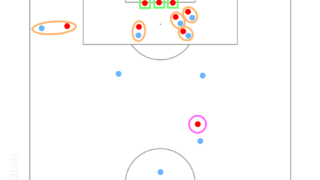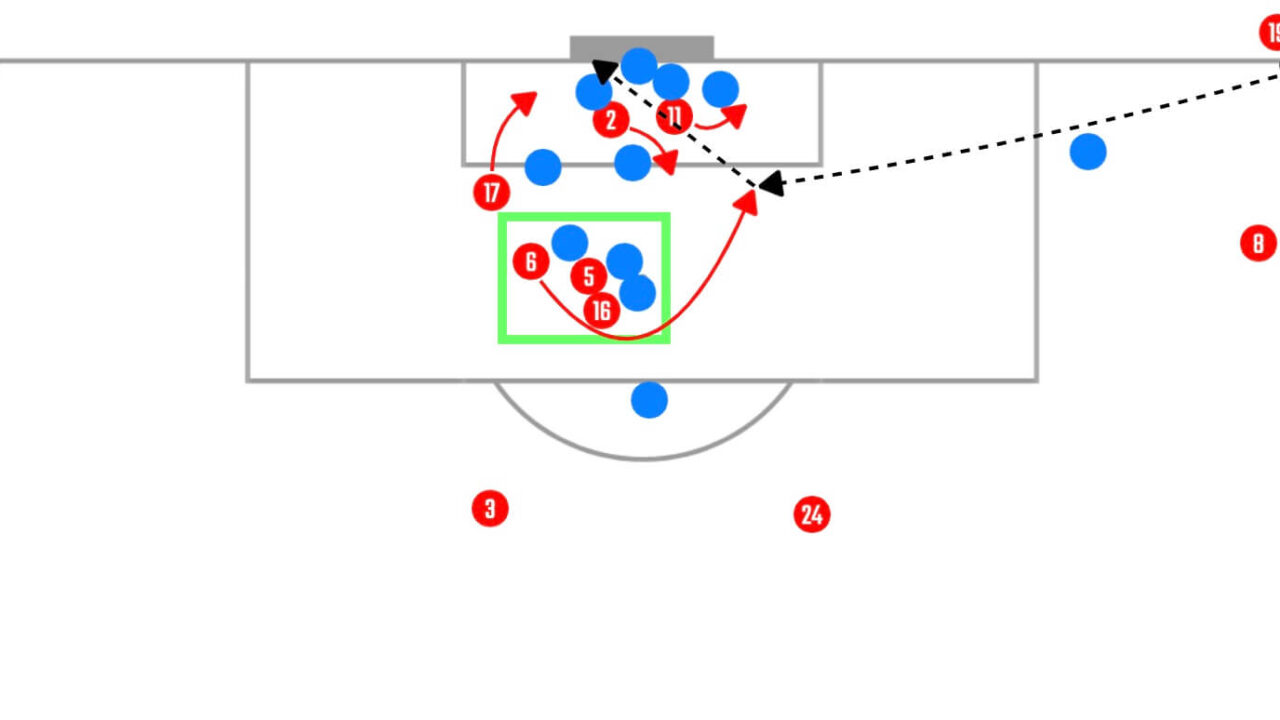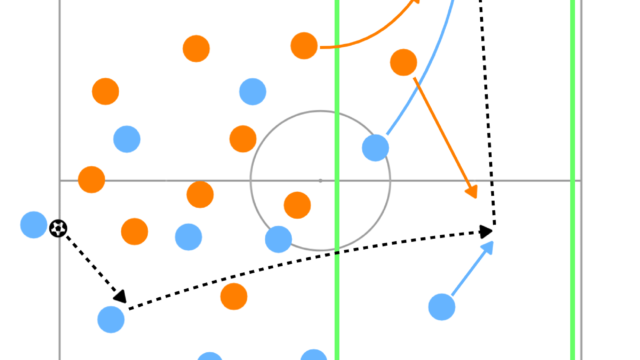Introduction
From their promotion to the Premier League in 20-21, Brentford have impressed the world by their unique strategies. On the pitch, their effort towards the set pieces is one of the best in the league and definitely contributed to their survival last season. In fact, the set piece coach of Arsenal in 22-23 is Nicolas Jover and he joined Manchester City from Brentford in 2019 and then moved to Arsenal. Additionally, Jack Wilson, one of former performance analysts of Brentford has also joined Manchester City as set piece analyst in the following year. This shows the fact that the coaches or analysts at Brentford who plan tactics or strategies of set pieces are considered so valuable. Therefore, in this article, the tactics of attacking corner kicks and free kicks of the Bees in 22-23 will be analysed to find out their principles. I hope you will enjoy it.
Attacking Corner Kicks
In attacking corner kicks, they use “blocking” strategies in many cases and aim not only to head the ball but also to create chances to take a volley. Additionally, their shape is so aggressive. There are six or even seven players in the box and two players around the corner with leaving only two outfield players around the D. This looks vulnerable to the opposition counterattacks, but as they put many players in the box, most of all opposition players need to come back in the box, so they hardly face the opposition counterattacks.
Another characteristic is that there are often two players around the corner. This can give an option to play short and a variety of deliveries. For example, when delivering the ball by out-swing from the corner, the ball cannot be delivered to the deep area beyond the back post. However, if the ball is kicked away from the goal line, it becomes possible.

Additionally, two kickers around the corner can prevent them from adapting the defensive shape for in-swing or out-swing. It is popular to change the shape slightly depending on the type of delivery, but if there are left-footed Bryan Mbeumo (19) and right-footed Mathias Jensen (8), it is impossible to predict it.
In terms of players, Mbeumo and Jensen are the main set piece takers and Ben Mee (16), Ethan Pinnock (5) and Christian Nørgaard (6) are the main target players. Ivan Toney (17) can also be a target, but he often runs towards the opposite side from where the ball is delivered in order to tap it in after it is flicked at the first post or headed back from the back post. Additionally, to maximise his ability as a striker, he is often selected to take a volley from the corner kicks. Other two players in the box usually block the opposition defender or make a dummy run.
First Post
The most frequent pattern is flicking the ball at the first post with blocking the opposition near post guard. The strength of this pattern is that it is possible to use against most of all opponents. No matter how the opposition team defends, there are one or two players defending zonally around the first post. Therefore, this pattern can be seen in most of all games. If you want to understand this kind of principle of defending corner kicks, I recommend you read this article below.

However, how to run towards the space around the first post is different between against zonal defending and man marking. If the opposition team defends with a zonal setup, all players positioned themselves behind the opposition defenders and pop up in front of them as soon as the ball is delivered. Thus, the attacker who tries to flick the ball at the first post makes diagonal run towards the space.

Not only the target player but also players blocking the opposition near post guard will position themselves behind the defenders and pop up in front of them. This is well organised pattern against a zonal setup.
On the other hand, against a man marking setup, it is required to lose the marker to head the ball away from the pressure. In this case, the Bees makes a screen with two players to free the main attacker.

The target player moves around the screen set by two players to prevent the marker from marking him and create a chance of the free header at the first post. These are the differences depending on the opposition set up when attacking the first post with the blocking strategy.
However, sometimes they do not use the blocking strategy. In this case, the target players will attack the first post in line together. When using the blocking strategy at the first post, only an attacker will attack the ball. Therefore, the ball has to be precise enough to meet the target player. Additionally, if the opposition setup is zonally and occupying the space at the near post, it is difficult to create a space. In this case, Brentford get all three or four target players to attack the first post in line.

In this case, all target attackers can be on the line of the delivery. Thus, the possibility of finding someone to head the ball can be higher. This tactic contributed to the win against Liverpool at home this season.
Not only finding someone’s head in the air, but also the Bees have a tactic to let a target attacker take a volley at the first post and it worked beautifully against Fulham this season. The basic of this tactic is same as the blocking strategy, which is blocking the near post guard and creating a space at the first post. However, this time, the ball is delivered by out-swing and also very low.

This kind of strategy is often regarded as trick pattern, but it is effective and gives some varieties for their attacking corner kicks tactics.
Back Post
Not only towards the first post, but also the ball can be delivered to the back post. However, basically, the strategies do not change. Even though the ball is delivered to the back post area, they use the blocking strategy to give time and space for the player heading the ball back to the space in front of the goal and against man marking setups, they use a screen to lose the marker. Usually, the ball is headed back by one of the target players, but sometimes it is aimed to let Toney take a volley at the far side by a straight ball.

Therefore, the key principles do not change depending on where to deliver the ball. However, in terms of the special occasion, after the ball is played short, the ball is often crossed to the far side. As soon as a short corner is chosen, all players in the box need to adjust their positions to avoid offside. In this situation, target attackers such as Mee or Pinnock are positioned in the far side and the ball is delivered there.

So far, the tactics of attacking corner kicks were discussed. The key principles are blocking and screening strategies, but there are some unusual patterns. Those simple principles can make it easier for players to perform different patterns and some tricky patterns make it unpredictable.
Attacking Free Kicks
The biggest characteristic is that they can turn any free kicks in the opposition half into goal scoring set pieces. Not only in the final third, but also they can play a long ball from the halfway line and progress the ball into the box. Firstly, however, the tactics in the final third will be analysed.
Final Third
When they earn a free kick in deep wide areas, the ball is often delivered by in-swing to aim to flick the ball at the near side. However, if the ball can be delivered in front of the 18-yard line, it is out-swing and aims the space in the middle or far side. There are those differences, but again, there is a simple principle. Like they perform in corner kicks, they use the blocking strategy here again.

One of the players moves behind the marker of the target attacker and tries to block him just before the opposition defenders start to move back. Usually, defenders will drop back before the ball is struck. Therefore, if the timing is perfect, this cannot be offside. So basically, they use the blocking strategy in free kicks in the final third. Therefore, there is a way to deliver the ball to the far side with the blocking strategy like they sometimes do in corner kicks.

This pattern is performed for mainly longer free kicks but thanks to this blocking strategy, they can enter the opposition box comfortably. And actually, they scored the equaliser from this pattern against Arsenal at Emirates.
Long Free Kicks
When playing longer free kicks, they often try to play in behind in the ball side. There are mainly two ways to play in behind. Firstly, someone up front makes a run in behind before the opposition team finishes to organise the defensive shape. Even though after earning free kicks, unless the referee stops the game it is possible to restart the game quickly. Then, as soon as realising the delay of organising their defensive shape, one of attackers make a run in behind and play there. Another way is playing short horizontally then long in behind. Just playing in behind is easy for the opposition team to deal with. Therefore, before playing long in behind, they often play short horizontally. This will force the opposition players to turn their body angle or view, and there will be the blind side.

Additionally, thanks to the angle of the pass, it is easy for the player running in behind to deliver a cross into the box. Overall, there were some similarities between tactics of attacking corner kicks and free kicks.
Conclusion
The attacking set piece tactics of the Bees are planned based on some key principles. Thus, it is easier for players to perform different routines weekly thanks to the principles behind them. Additionally, some trick patterns such as aiming to take a volley or quick restart in free kicks can provide variety for the team and make it unpredictable for the opposition teams. Thanks for reading. I hope you enjoyed this.



